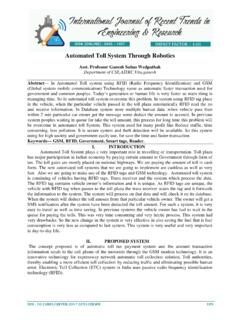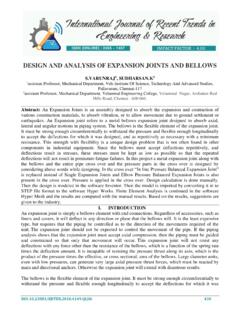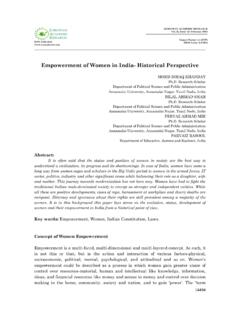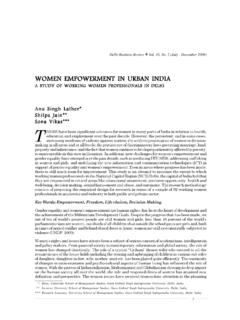Transcription of Role of women empowerment in economic growth in India
1 @IJRTER-2016, All Rights Reserved 177 Role of women empowerment in economic growth in India Dr. kirti shrivas (Asst. professor)Dept. of Commerce, govt. college abhanpur Abstract : women s empowerment defined as improving the ability of women to access the constituents of development in particular health, education, earning opportunities, rights and political participations. women empowerment in India is dependent on many different variables like education status, social status, geographical status and age. This paper is focused to economic participations and opportunities for women . There is very close relation between economic development and women s empowerment .
2 The main objective of this study is to identify an economic status of women s economic , educational and empowerment status. I. INTRODUCTION Woman empowerment itself elaborate that social rights, political rights, economic stability, strength and all other rights should be equal for both gender. There should be no discrimination between man and women . Swami Vivekananda, one of the greatest sons of India , quoted that There is no chance for the welfare of the world unless the condition of the woman is improved. it is not possible for a bird to fly on only one wing. India needs to transform colossal women force into an effective human resources and this is possible only through the empowerment of women .
3 The Govt. of India is running various welfare schemes both at state & central level for the empowerment of the women . All policies and programs focus on social, economic and educational empowerment of women across various age groups. II. THE MAJOR TYPES OF EMPOWERMENTS ARE:- 1. Educational empowerment : - Education is an important factor to progress in life. It means empowering women with the knowledge, skill and self confidence necessary to participate fully in the development process. It means making women aware of their rights and developing confidence to claim them. 2. Social women empowerment : - A critical aspect of social empowerment of women is promotion of gender equality.
4 women face many social challenges today, whether it be making soaps and license in order to secure an income for their family. 3. economic empowerment : - It implies a better quality of material life for a sustainable livelihood owned and managed by women . There is a strong correlation between economic development and women s legal rights. 4. Political empowerment : - The existence of political system is favoring the participation by women in the political decision making process and in governance. infusing other government policies and decisions the affect on rural communities, changing town based peoples beliefs, networking with people in government and industry and other women to discuss and rural communities.
5 5. economic empowerment :- International Journal of Recent Trends in Engineering & Research (IJRTER) Volume 02, Issue 11; November - 2016 [ISSN: 2455-1457] @IJRTER-2016, All Rights Reserved 178 There is a bidirectional relationship of economic development & women empowerment defined as improving the ability of women to access the constituent of development. economic development can also lead to the empowerment of women by freeing their time. The world that is interested in women s right favors for economic development. women contribute to the Indian economy in many ways. Apart from her importance in the social framework, a women s vital role in village centric community activities, protecting our culture and in determining the consumption attitude makes her special for economy.
6 The high growth figures of 8 to 9 percent of Indian economy depend basically on high rates of its gdp of which 70 percent comes from household saving, 20 percent from private sector and rest 10 percent from public sector. Household saving in the country is all due to women as it is a part of the culture of the Indian society is to do savings. Report of the working group on empowerment of women XI plan concedes, with the growing globalization and liberalization of the economy as well as increase in privatization of services. women as a whole have been left behind and not been able to partake the fruits of success.
7 Although most women in India work and contribute to the economy in one form or another, women plow fields and harvest crops while working on farms, women weave and make handicrafts while working in percent women involve in informal sector. The informal sector includes jobs such domestic servants, small traders .we understand that contribution of Indian women is neither appropriately accounted nor our policy makers have the vision to approach the importance of women for development of the economy. III. MAJOR ISSUE IN women economic empowerment (1) economic backwardness: - women constitute only 34% of the work force but forms majority of the destitute in the country.
8 The World Bank has identified empowerment as one of the key constitutes elements of poverty reduction and as a primary development assistance goal. (2) Implementation gaps: - Through all these year the attentions is any developing & devising new scheme policies and programs and have paid less attention to the proper monitoring system and implementation. (3) Lack of political will. (4) women as unpaid family workers in subsistence agriculture. (5) Low level of technology and primitive farming practices. (6) Poor access to credit and marketing networks. (7) Social and cultural barriers such as executive responsibility for household work, restrictions on mobility etc.
9 III. CONCLUSION empowerment of women socially, economically, educationally, politically and legally is going to be a Herculean task. It is not going to be easy to change the culture for disrespect for women . Only revolution can bring changes in a day, but reforms take their time. women have a unique position in the economy. If women gain economic strength they gain visibility and voice. women s direct participation in decision making capacity and income generation activities can make significant contributions towards International Journal of Recent Trends in Engineering & Research (IJRTER) Volume 02, Issue 11; November - 2016 [ISSN: 2455-1457] @IJRTER-2016, All Rights Reserved 179 women empowerment .
10 Entrepreneurship can help women to gain economically strong which may help them in improvement of their social status. REFERENCES 1. Malhotra Anju, Sidney Ruth Scheduler and Carol B oender (2002) Measuring women s empowerment as a variable in International Development., World Bank Social Development Group. 2. Government of India (2011) Human Development report -2011: Towards Social Inclusion, Oxford. 3. Sunita Kishor and Kamla Gupta (2009) Gender Equality and women empowerment in India , National Family Health Survey (NFHS-3) India 2005-06. 4. Government of India (2010) Annual Report To The People on Employment, Ministry of Labor and Employment, New Delhi.













